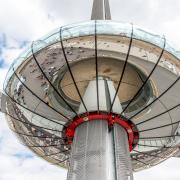The story of England as we know it has its roots here in Battle, the place where William, Duke of Normandy, claimed victory over the last Anglo-Saxon, King Harold, along with the throne. Nowadays, it’s a delightful market town that manages to retain that aura of history coursing through its streets
GREAT GATEHOUSE
The Great Gatehouse of Battle Abbey dates from 1338, although the Abbey itself was founded by William the Conqueror not long after the famous battle of 1066. The gatehouse dominates the High Street, drawing visitors from all over the world. It’s possible to climb the ramparts above the main entrance and be rewarded with a fine view over the Abbey Green and down the High Street.

BATTLE ABBEY SCHOOL
Now one of the country’s finest independent schools, Battle Abbey School occupies some of the old Abbey buildings and Manor House. The school itself was founded 111 years ago in 1912.

THE CHAPTER HOUSE AT BATTLE ABBEY
Believed to be the novice’s common room in the dormitory building of the Abbey. Novices were those adopting part of the monastic code as a step towards their ordination into the church. It’s a beautiful, atmospheric room and was used by local rock band Keane to shoot videos you can easily find on YouTube.

MOUNT STREET
Lewins Croft, in Mount Street, is an incredible 16th century Grade II* Listed building with so few straight lines it almost seems to have been made out of rubber. But it’s a beautiful thing, and a prized asset for the town. It was originally an Inn on the old road to London.

THE BATTLE TAPESTRY
The Battle Tapestry, on display in St Mary’s Church, was unveiled in 2017. It’s a community project in the style of the original Bayeux Tapestry and aims to show the development of Battle between William’s victory in 1066 and the founding of St Mary’s in 1115. My schoolboy Latin tells me that this section appears to show the coronation of William II (William Rufus) at Westminster Abbey, in 1087.

HIGH STREET
It feels like almost every building in the High Street is Grade II Listed. This small selection pictured is no exception. However, the narrow tall building in this picture is what’s known as a ‘slip’. That is, a building that fills in a passageway that was there previously.

TANK TRAPS
There is a private car park next to St Mary’s Church at the bottom of which is the Community Hall used by the 1st Battle Scout Group. It’s easy to ignore the rather ugly lumps of concrete as you walk there but these are actually tank traps dating from the early part of the second world war, when this was considered an area at risk of invasion. These are rare surviving examples of such defences, called Dragon’s Teeth or, in the original German, Drachenzähne.

PORTELLI SCUPLTURE
This brilliantly-original sculpture on the Fire Station roundabout leading into town from the west is by Guy Portelli, which appeared in 2016. It depicts William of Normandy’s minstrel, a man called Taillefer, the first man sent out in the field to taunt the English. He killed the first English soldier to confront him, after which he himself was killed.

MARLEY LANE
Marley Lane leads from the town roughly north-east towards Sedlescombe. It is one of a few local landmarks referenced by the alternative rock band Keane in their hit song, “Sovereign Light Cafe,” Battle being where most of the group grew up. Other local landmarks referenced in the song include North Trade Road, Powdermill Lane, the battlegrounds and, obliquely, the station.

Charlotte Moore – ‘I’ve known Battle all my life and, in essence, it hasn’t changed all that much in that it is a small, country town. It’s a small, friendly place but it punches above its weight in terms of history. The layout of the town - the High Street leading down to the Abbey and then, beyond the Abbey, down the hill towards the station is still the medieval layout. Shopfronts change, they come and go but if you look along the rooftops, you’ll see it’s a very, very ancient town.’

Robert Catt – ‘The history of this town is great and it’s all still there; the fascination with 1066 and the history beyond that. You only have to walk to see the old powder mills and the old iron works that are here, the woodlands still full of voices and noises, redolent of the past. It’s all still here and it’s a lovely community.’
* With thanks to Peter Greene and Georgina Doherty from the Battle and District Historical Society for their invaluable help.



























